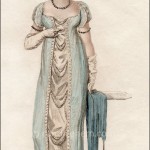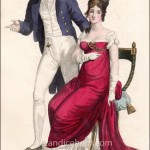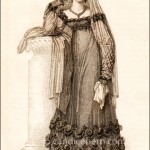Ackermann’s Repository of Arts, January 1811.
“Evening Dresses”
 I love this print, especially the way the ladies are positioned, as if they’re whispering about certain gentlemen, perhaps. Each gown includes black elements. This is because of the death of Princess Amelia, youngest daughter of George III, in November 1810. At the time the magazine went to print, 6-7 weeks later, full public mourning was over, but many people, especially those with ties to the Court, would have continued to honor the princess with black gloves, black trimming, black ribbons, black jewelry, etc.
I love this print, especially the way the ladies are positioned, as if they’re whispering about certain gentlemen, perhaps. Each gown includes black elements. This is because of the death of Princess Amelia, youngest daughter of George III, in November 1810. At the time the magazine went to print, 6-7 weeks later, full public mourning was over, but many people, especially those with ties to the Court, would have continued to honor the princess with black gloves, black trimming, black ribbons, black jewelry, etc.
The print is described in the magazine as follows:
“Erect Figure. — A French frock, with demi-traine of black imperial gauze, worn over a slip of white sarsnet or satin; the bottom, bosom, and short sleeve ornamented with a Vandyke border of white velvet or thread lace. A white velvet or satin hat, ornamented with two curled ostrich feathers, with a silver or beaded band. White kid gloves and shoes.
“Sitting Figure. — An elegant Grecian robe of silver grey crape, worn over a white satin under-dress, ornamented at the feet and down each side of the figure with a light and tasteful border of black bugles. Stomacher of the same, edged with black beads, corresponding with those which finish the bosom and sleeves. Ear-rings, necklace, and bracelets of jet. Hair in waved curls on each side of the face, divided in front of the forehead with a full plait, and ornamented with a barrel comb of jet. White satin slippers, with black jet clasps or bugle rosettes. White kid gloves, and a fan of silver-frosted crape.
“Back-ground figure. – A robe of black Venetian velvet, with short Circassian sleeve, gathered in a knot of white beads or pearl; the bosom and stomacher to correspond. Pearl necklace, ear-rings, and bracelets. Belt of white velvet, with mother-of-pearl clasps. Convent veil of white cobweb net, confined in front with a pearl crescent, à la Diana. Sandal slippers of white kid. Gloves of the same, and fan of carved ivory.”







